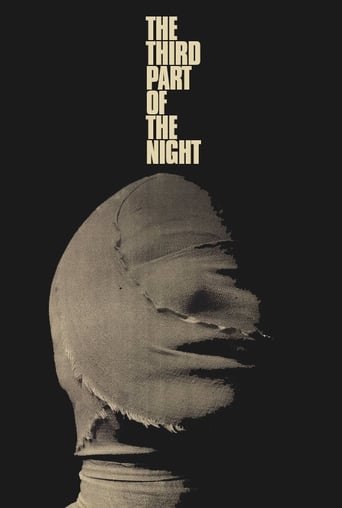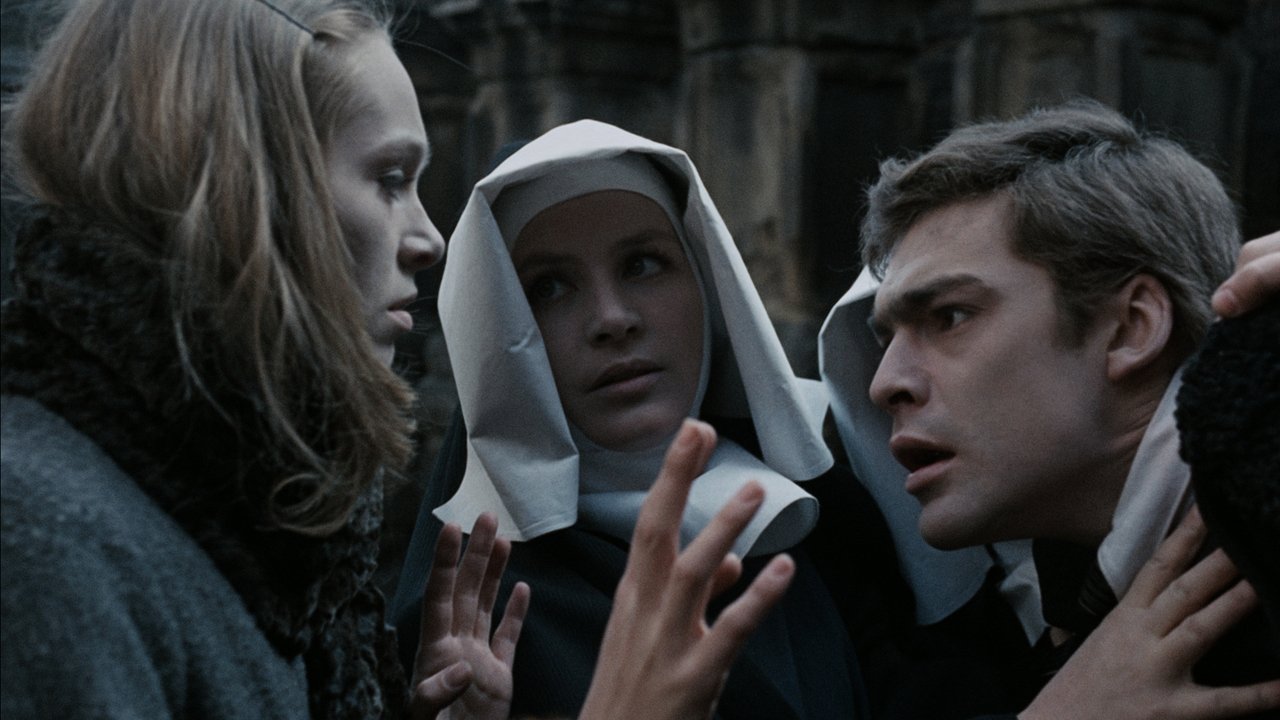rbbdagge
The film jumps between time-lines and characters in a somewhat confusing manner with dead figures re-appearing throughout the film, so trying to give a detailed story-line is somewhat pointless. The dialogue is extreme and sometimes absurd, but that only adds to the atmosphere of a character being eaten by lice and perhaps in a fever. The lice thing is based on fact - Polish resistance fighters were happy to put themselves forward for scientific experimentation with lice (in an effort to eradicate typhoid), as no German soldiers would go near them if their cards said that they were involved in the programme. The lice in any case are a symbol of war - people sucking the blood out of each other etc. A chaotic and incoherent film, but amazing first-time direction from Zuwavski. It is all filmed in hand-held camera (usual stuff now, but extremely unusual back in the early 70's), so there is a lot of movement. The film was made in Krakow and the city looks nothing like is now - an empty desolate filthy city of dilapidated grey building. Very Kafka-esque indeed, with stark bleak colours. I liked the film for atmosphere and cinematics, but many will not if they concentrate on the story and often somewhat obscure dialogue.The film was a big thing when it came out in Poland with huge queues to see it by the public - it has lost its relevance today and looks VERY dated (ie. as does all Polish 1970s cinema), but is still an interesting view.
AgentSniff
I have watched into the void and it's filled with lice. The Third Part of the Night has been described as many things, but HORROR is the one word that makes justice to it. The one thing mostly remotely like it are the Silent Hills games and Come and See. At first I could not tell that the film was set in WWII, but when it became apparent to me, the riddle of the film also became apparent. Most of the film is actually a rather straightforward film, but the way the events are realized it becomes a surreal vision of the end of the world. I have trouble describing it other than a disturbing nightmare about the end of time. A furious debut of a filmmaker, possessed by the Gods of film, who summon a town beyond space, time and hope.
chaos-rampant
I don't like to treat movies as simply fictions to pass the night, that way lies the habit of simply partaking of culture. The whole point is that we're roped in life by forces that have significance for us - and if film is to be a truthful reflection, it will devise ways to portray this pull, turn it into something we can see.This is how I welcome Zulawski. It's not because of what he has to say or because themes might be important, here Polish life under Nazi horrors. Similarly I don't reject him because stories are muddled or the acting is hysteric. I welcome him because he can use the eye of the camera to rope forces that move us.On the surface this is a glimpse of anguished life during WWII, but not the mock historical type that seeks to enshrine bygone events in pious ceremony. This is one that speaks very much about anxiety that haunts the soul now in this very life, rending the air with dread and confusion. Horror that is very much present and didn't go away with the war but still lingers. He would rail - more or less covertly - against a repressive Soviet regime in later films as well.So he's angry with god that won't manifest, he shouts dejection at a broken state of things, everything he would become known for is already present here, fully formed as template. But no answer can be found in the mind that despairs and clamors and none would suffice to explain anything. No his power is that he can show these things truthfully for what they are, confusion as confusion, ignorance as ignorance. So of course the narrative becomes oblique, muddled, sense takes flight and we're left with fragments.He's still striving to burst forth here, not yet channeling madness through the eye to alter how we see. That would come to him in due time. But everything you need to know about him you'll see in the very beginning of this first film.A man's wife and child are taken from their house one day and murdered in the yard; evil that swoops over this world and wrecks lives. He joins the resistance and immediately people are chasing after him and shooting to kill him, agents of that evil. So he hides in an apartment building and by a chance turn of fate, police arrest someone else in his place, someone with the same color of coat who was going up the stairs to a pregnant wife. In a stunning turn he helps the wife give birth, becoming the husband who was taken away.Jancso and Tarkovsky were previous masters of the floating eye who could maintain equanimity in the face of horror and misfortune; he is ruptured by it, splintered in selves. But it's still the same deep roar from the engines of consciousness that propels him.
oOgiandujaOo_and_Eddy_Merckx
The Third part of the night is set in Poland during the second world war, which, as you will probably know, was infested by the plague of Nazism, and latterly equipollent Communism. The film starts with a quotation from Revelations Chapter VIII, which delineates the havoc that will be wreaked upon the earth when the Big Guy decides it's time to wrap everything up. There are seven trumpets being blown, the first four we are told about, and they wreak chaotic damage to earth, generally in thirds: a third of the rivers are turned to wormwood, one third of ships destroyed... Anyway the fourth trumpet makes it so that for a third part of the night the moon and stars will not shine, so that's basically what the German occupation of Poland is, the Third Part of the Night.Most of the film is set in the city of Lwow, which was then part of Poland, but now has been made part of Ukraine and is called Lviv. That was Joe Stalin's doing, part of his Polish Holocaust.The film starts though in the countryside with a violent act that is a quotation of the violence at the start of Menilmontant if I have seen things correctly. Michal the main character, a ghost-faced unibrowed typhus sufferer loses his family and returns to Lwow, where he attempts to become part of the resistance. It turns out that the resistance centers around a research institute. The folks there exist to feed lice. The way it works is that you put a strap around your bare leg and slot in these matchbox size containers full of lice that feed from your blood through a wire mesh. These lice are used to breed typhus, and the vaccine is then prepared from their guts. One guy gets home from work, strips naked and starts scratching himself and whimpering. Not the most pleasant scene. Involving yourself in this process gave you great papers though, because the Germans took one look at your papers, and were then scared of catching typhus from you and so left you well alone.After losing his wife, Michal comes across a woman who looks exactly like her (a plot device Zulawski also uses in La Femme Publique). It's not clear why this device is used, but it could be a misogynist motif, ie. he's incapable of seeing the woman for who she is, he may also be having a traumatic hallucination, which would mean that there is a woman but she doesn't look like his wife. This *hallucination* of a movie is mainly anchored around this plot, providing some sort of bearing for the viewer.You won't see a normal moment in the entire movie, everything is topsy turvy, every scene is either in a shattered building, or of a normal building full of shattered people. It's a nightmarish movie, like a dance of death. Dance is an appropriate word because the film uses hand-held camera a lot (though Zulawski in an interview has stated that the cameraman he found had a very steady hand, and he was obviously proud to find him), and the shot dances around, with some circular shots, zooms you never see coming, really it's very alive.What really is the Zulawski strength though is directing actors, he managed to coax scenes of incredible intensity out of Malgorzata Braunek (as Michal's wife) and Jerzy Golinski (Michal's father). I've seen almost nothing like it, though another Polish film springs to mind, Jerzy Kawalerowicz's Mother Joan of the Angels. The actors handed themselves over to Zulawski, giving them his complete trust, Braunek in particular in one scene at the institute connected with some deep innermost primal emotions.The cellar shots at the institute are the bleakest shots you're likely to see in cinema, and remind me only of paintings, and bizarrely of the shots of test chambers in Alien 4.The only big stumbling block for most people I believe would be the music, which is very out-of-place jazz (three quarters of the way between mellifluence and dissonance), and has taken me a while to get used to.


 AD
AD



